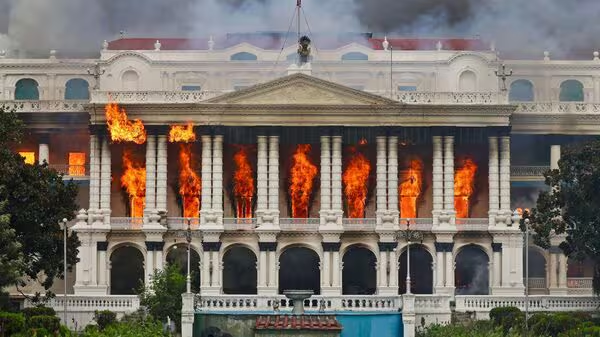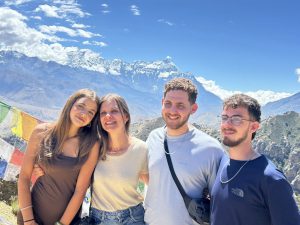The September 8–9 2025 Uprising and Its Ripple Effects on Travel, Economy, and the Nation’s Image
Nepal’s tourism industry — long hailed as a story of resilience — now faces one of its biggest challenges since the 2015 earthquake and the pandemic. The Gen Z protest movement of September 8–9, 2025, a youth-led revolution demanding transparency, reform, and accountability, erupted into widespread violence that left a trail of destruction across the nation.
What began as a social awakening has ended up reshaping Nepal’s tourism landscape, damaging infrastructure, shaking investor confidence, and forcing a rethink on how the country manages stability and image in a globalized travel economy.
What Happened: From Protest to Crisis – Impact of the Gen Z Protest on Nepal Tourism
The protests started peacefully, led mostly by Gen Z activists calling for reform, fair employment, and digital freedom. Within 48 hours, frustration exploded into chaos, turning Kathmandu and major cities into flashpoints.
- Government buildings, including Singha Durbar, the Parliament complex, and parts of the Supreme Court, were burned or vandalized.
- Two of Nepal’s most prestigious hotels — Hilton Kathmandu and Hyatt Regency — suffered severe fire damage.
- Dozens of government and private vehicles were torched.
- Several police stations and municipal offices were ransacked.
- Local levels (municipalities and rural wards) — 89 completely destroyed and 124 partially damaged, according to My Republica.
The destruction was swift and shocking, particularly for a country where tourism and service industries are key drivers of employment and GDP.
The Economic Cost – Impact of the Gen Z Protest on Nepal Tourism
Preliminary government estimates put total damage to infrastructure at over Rs 900 billion (approx. USD 7 billion) – nearly 20% of Nepal’s national budget.
- Hotel and tourism sector losses: Rs 25–30 billion (Hotel Association Nepal)
- Public infrastructure: Rs 100 billion
- Vehicles and logistics: Rs 4 billion
- Private businesses: Rs 80–100 billion
- Insurance claims filed: Rs 23.22 billion (Non-life insurance companies, October 2025)
The immediate loss is not just physical but psychological – for investors, tourists, and even locals who depend on the tourism economy for survival.
Direct Impact on Tourism – Impact of the Gen Z Protest on Nepal Tourism
1. Hotel & Hospitality Sector
Luxury hotels, resorts, and local lodges were among the hardest hit. The fire at Hilton Kathmandu alone caused damage worth Rs 8 billion, while in Pokhara, around 10 hotels — including Bagaincha Resort and Pokhara Events Centre — reported losses in the range of Rs 400 million to Rs 1 billion each.
More than 2,000 hotel workers have lost jobs or been placed on unpaid leave. Many properties remain closed or under renovation during what should have been the peak autumn tourism season.
2. Travel Cancellations – Impact of the Gen Z Protest on Nepal Tourism
According to Tourism Mail Nepal, daily international arrivals plunged from around 3,300 visitors per day to 1,400–1,600 in the days following the riots.
Cancellations reached nearly 40% for hotels and trekking agencies. Many tourists already in the country shortened their stay or shifted to rural areas perceived as safer.
3. Brand & Reputation Damage – Impact of the Gen Z Protest on Nepal Tourism
The global tourism market is highly image-sensitive. The visuals of burning hotels and chaotic streets circulated widely online, denting Nepal’s reputation as a peaceful Himalayan haven.
Several foreign embassies issued travel advisories, warning citizens to avoid unnecessary travel until stability returns.
4. Operational Challenges – Impact of the Gen Z Protest on Nepal Tourism
Beyond the destroyed properties, the protests disrupted supply chains, bookings, and services like airport transfers and trekking permits. Many local tour operators had to halt operations for several days.
Broader Ripple Effects – Impact of the Gen Z Protest on Nepal Tourism
Investor Confidence Shaken
The hotel and tourism boom that followed post-pandemic recovery has been abruptly disrupted.
Luxury chains, boutique hotels, and adventure companies are re-evaluating expansion plans. Foreign direct investors are now demanding stronger political guarantees and insurance before re-entering Nepal’s hospitality market.
Loss of Employment & Income
Tourism provides over 1 million direct and indirect jobs in Nepal. The protests led to layoffs not just in hotels, but in transport, trekking, restaurant, and handicraft sectors.
Community Tourism Under Strain
While big hotels were headline victims, rural tourism and homestays have also suffered due to fewer domestic visitors. Small guides, porters, and local suppliers face income gaps, worsening the urban-rural divide in Nepal’s tourism economy.
Erosion of Confidence Among Tourists
Even if physical safety improves, perceived instability lingers. For many potential travelers, headlines of “riots” or “burning parliament” outweigh later reassurances of calm.
Resilience and Hope: Nepal’s Strengths Remain
Nepal’s tourism industry has proven its resilience time and again — through the 2015 earthquake, the border blockade, and the COVID-19 pandemic. Within weeks of the 2025 protests, signs of recovery have already begun:
- Tourist arrivals rebounded to around 2,800–2,900 per day by early October.
- Trekking regions like Everest, Annapurna, and Langtang remain safe and open.
- Domestic tourists, especially from nearby South Asian markets, have shown willingness to return quickly once normalcy stabilizes.
Nepal’s authentic experiences — its people, culture, Himalayas, and spirituality — are timeless assets. With proper crisis management and transparent communication, these strengths can again attract visitors from around the world.
Quick Facts: Before vs. After
| Category | Before Sept 8 | After Protests | Change |
|---|---|---|---|
| Daily Tourist Arrivals | ~3,300/day | 1,400–1,600/day | -50% |
| Hotels Fully Operational | 95% | 60% | -35% |
| Jobs Supported by Tourism | ~1 million | ~800,000 (estimated) | -20% |
| Estimated Economic Loss | — | Rs 900 billion | — |
Road to Recovery: What Nepal Must Do
1. Restore Key Infrastructure Quickly
Fast reconstruction of Hilton, Hyatt, and heritage sites must become a national priority. Visible rebuilding sends a message of capability and confidence.
2. Financial Support to Tourism Businesses
- Provide low-interest reconstruction loans and tax relief for affected hotels and tour operators.
- Simplify insurance claim processes.
- Launch a Tourism Recovery Fund to help small and medium-sized operators.
3. Communicate Stability Clearly
- The Nepal Tourism Board, Hotel Association Nepal, and private sector must jointly communicate that Nepal is open, safe, and welcoming again.
- Launch a global campaign titled “Nepal is Rising Again” highlighting resilience and recovery.
- Engage influencers and content creators to share real-time updates showing normalcy.
4. Invest in Safety and Crisis Management
- Improve fire and emergency response in tourist zones.
- Create an emergency hotline and travel information portal for visitors.
- Train local authorities and hotel staff in crisis handling and guest communication.
5. Engage Gen Z Positively
Ironically, the very generation that led the protest could be part of the solution.
Gen Z wants transparency, sustainability, and inclusion — principles that align with responsible tourism.
By involving youth in eco-tourism, digital storytelling, and entrepreneurship, Nepal can transform protest energy into constructive innovation.
6. Rebrand and Rebuild Confidence
Nepal’s global identity must move beyond images of destruction. Highlight:
- Eco-friendly trekking and volunteering programs
- Festivals and cultural revival stories
- Authentic local experiences that show community spirit

A targeted marketing push in major markets (India, China, Europe, and the U.S.) with strong visuals and reassurance will help accelerate the bounce-back.
What Travelers Should Know
For travelers planning to visit Nepal:
- Most trekking routes and major destinations — Pokhara, Chitwan, Everest region, Annapurna Circuit , Langtang, Manaslu – are open and safe.
- Hotels and airports have resumed operations.
- Always check updated travel advisories and choose flexible bookings with clear refund policies.
- Local guides, porters, and communities welcome you warmly — every visit now helps rebuild livelihoods.
A Test of Resilience — and a Chance for Renewal
- A Test of Resilience — and a Chance for Renewal
- The Gen Z revolution has exposed deep frustrations but also highlighted the strength of Nepal’s civil society and its youth. For tourism, this is both a challenge and a chance — a moment to redefine priorities toward sustainability, good governance, and crisis readiness.
- Rebuilding damaged properties is one thing; rebuilding trust is another. If Nepal acts swiftly, communicates transparently, and embraces reform, this tragedy could mark the beginning of a new, more accountable era for the tourism industry.
- Nepal has always risen from the ashes — and it will again. The mountains still stand tall, the culture remains rich, and the spirit of the Nepali people continues to welcome the world with open hearts.
Key Takeaway: The Gen Z protests have damaged infrastructure but not Nepal’s spirit. With leadership, collaboration, and resilience, tourism can not only recover but evolve into a stronger, fairer, and more future-ready sector.
Red Reach Himalaya is your trusted Nepal travel partner, offering guided treks, tours, and adventure experiences while connecting travelers with Nepal’s culture, mountains, and people. Learn about us.











